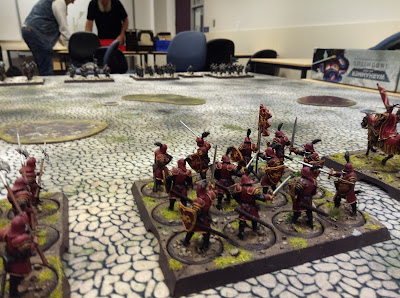Kyran offered to demo a game of 'A Song Of Ice and Fire' last night, so I volunteered to give it a go. It's basically a Warhammer type game, with units consisting of trays of figures, and a pretty simple roll hits/roll saves combat system. At the back of it, though, is the 'period' chrome, in the form of characters and faction-specific event cards. This gives each faction a unique feel.
He set up a game with five units a side - I took the Lannisters with their strong armour, bags of cash but slow troops, whist Kyran ran the Starks, who are lighter, faster and fiercer. We would score points for holding on-table objectives at the end of a turn, and killing enemy units.
Here we are set up.
Getting in the first attack is key, as only the charging unit rolls combat dice; the defender doesn't hit back. Of course getting in the first attack is no good if your opponent can then charge you in the flank; that's what happened after this photos was taken - my knights shattered the Stark cavalry, but were then flanked by Rob Stark's personal unit and pretty much wiped out.
Anyway, I managed to pull off a win - I think taking out a unit of berserkers early on, helped; it gave me control of one flank and the objective there, for a steady flow of points. I was then able to plonk a unit of guardsmen - strong in defence - on a second, high-value, objective, and finally Clegane's troops killed things and grabbed a final objective. Cersei Lannister was my behind-the-scenes winner, using her influence to keep the Stark army in a near constant state of demoralisation.
So all in all an interesting game if you like your miniatures games mixed with some diplomatic/political boardgame shenanigans. Reminiscent of Saga in some of the gameplay, as the on-table action is manipulated via off-table decisions, and it certainly captured the 'Game of Thrones' feel (although I admit I'm only familiar with the TV series). Certainly something I'd consider playing again one day.
And the figures are beautiful.






An interesting write up of an interesting game. Simple mechanics backed by a clever decision matrix to inject theme flavour is a winning design in my view, and Game Of Thrones provides the perfect tapestry. I love those figures... especially the hulking Gregor!
ReplyDeleteCheers,
Caesar